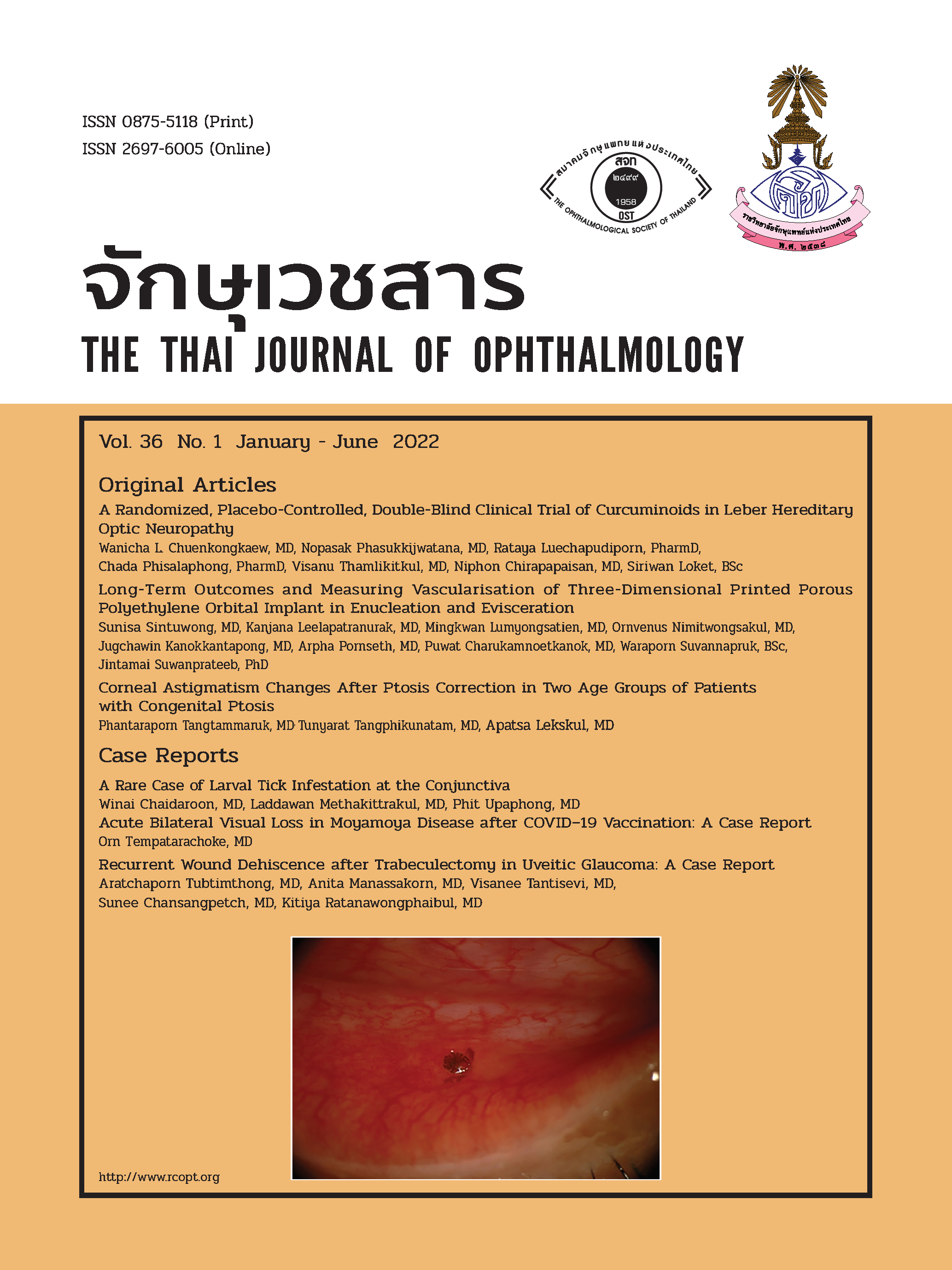Corneal Astigmatism Changes After Ptosis Correction in Two Age Groups of Patients with Congenital Ptosis
คำสำคัญ:
congenital ptosis, corneal astigmatism, refractive error, amblyopia, blepharoptosisบทคัดย่อ
Purpose: To evaluate postoperative corneal astigmatism changes after ptosis correction in groups of young and older patients with congenital ptosis.
Patients and Methods: A prospective cohort study of 28 patients (56 eyes) with congenital ptosis enrolled at Ramathibodi Hospital was performed from April 2018 to June 2019. Within this group of patients there were 6 cases of bilateral congenital ptosis and 22 unilateral cases of congenital ptosis forming a total of 34 individual ptotic eyes for the study. The patients were categorized into two groups: early-age group (aged ≤5 years,) comprising of 14 eyes and older-age group (aged >5 years) comprising of 20 eyes. The preoperative visual acuity, amblyopic status, ptosis severity, and refractive error of both groups were evaluated prior to ptosis correction. All patients underwent ptosis correction with either levator resection or frontalis sling. Following the correction, the refractive error was measured after a follow-up period of at least 6 months. The astigmatism results were classified into three subgroups: with-the-rule, against-the-rule and oblique astigmatism.
Results: The mean age at diagnosis was 8.91 ± 7.05 years. From the study group, amblyopia was found in 13 out of 28 patients (46.4%). The most common type of astigmatism was with-the-rule astigmatism, making up 24 out of 34 ptotic eyes (70.6%). A postoperative astigmatism change of >0.50 diopters was found in 4 out of14 eyes (28.6%) in the early-age group and in 6 out of 20 eyes (30.0%) in the older-age group (Rate ratio, 1.43; 95% CI, 0.34–6.07).
Conclusion: Astigmatism was reduced following ptosis correction, with no statistically significant difference in the amount of reduction between the two age groups. As there is no significant difference, surgical correction can be deferred in patients of all age groups with anisometropic amblyogenic ptosis until appropriate surgical planning is possible.
เอกสารอ้างอิง
2. Paik JS, Kim SA, Park SH, et al. Refractive error characteristics in patients with congenital blepharoptosis before and after ptosis repair surgery. BMC Ophthalmol. 2016;16(1):177.
3. Kao SC, Tsai CC, Lee SM, Liu JH. Astigmatic change following congenital ptosis surgery. Zhonghua Yu Fang Yi Xue Za Zhi (Taipei). 1998;61(12):689–693.
4. Savino G, Battendieri R, Riso M, et al. Corneal topographic changes after eyelid ptosis surgery. Cornea. 2016;35:501–505.
5. Stein A, Kelly JP, Weiss AH. Congenital eyelid ptosis: onset and prevalence of amblyopia, associations with systemic disorders, and treatment outcomes. J Pediatr. 2014;165(4):820–824.
6. Lee YG, Son BJ, Lee KH, et al. Clinical and demographic characteristics of blepharoptosis in Korea: A 24-year experience including 2,328 patients. Korean J Ophthalmol. 2018;32(4):249–256.
7. Oral Y, Ozgur OR, Akcay L, et al. Congenital ptosis and amblyopia. J Pediatr Ophthalmol Strabismus. 2010; 47(2):101–104.
8. Huo L, Cui D, Yang X, et al. A retrospective study: form-deprivation myopia in unilateral congenital ptosis. Clin Exp Optom. 2012;95(4):404–409.
9. Griepentrog GJ, Diehl N, Mohney BG. Amblyopia in childhood eyelid ptosis. Am J Ophthalmol. 2013;155(6):1125–1128.
10. Gusek-Schneider GC, Martus P. Stimulus deprivation amblyopia in human congenital ptosis: a study of 100 patients. Strabismus. 2000;8(4):261–270.
11. Wu SH, Ma L, Huang HH, Tsai YJ. Analysis of visual outcomes and complications following levator resection for unilateral congenital blepharoptosis without strabismus. Biomed J. 2013;36(4):179–187.
12. Cadera W, Orton RB, Hakim O. Changes in astigmatism after surgery for congenital ptosis. J Pediatr Ophthalmol Strabismus. 1992;29:85–88.
13. Kumar S, Chaudhuri Z, Chauhan D. Clinical evaluation of refractive changes following brow suspension surgery in pediatric patients with congenital blepharoptosis. Ophthalmic Surg Lasers Imaging. 2005;36(3):217–227.
ดาวน์โหลด
เผยแพร่แล้ว
ฉบับ
ประเภทบทความ
สัญญาอนุญาต
ลิขสิทธิ์ (c) 2022 จักษุเวชสาร

อนุญาตภายใต้เงื่อนไข Creative Commons Attribution-NonCommercial-NoDerivatives 4.0 International License.
The Thai Journal of Ophthalmology (TJO) is a peer-reviewed, scientific journal published biannually for the Royal College of Ophthalmologists of Thailand. The objectives of the journal is to provide up to date scientific knowledge in the field of ophthalmology, provide ophthalmologists with continuing education, promote cooperation, and sharing of opinion among readers.
The copyright of the published article belongs to the Thai Journal of Ophthalmology. However the content, ideas and the opinions in the article are from the author(s). The editorial board does not have to agree with the authors’ ideas and opinions.
The authors or readers may contact the editorial board via email at admin@rcopt.org.


